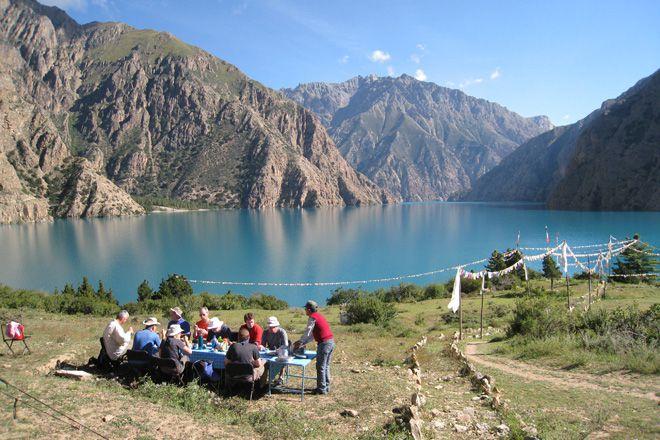Where next after Everest Base Camp?
For many people, trekking in Nepal means successfully reaching Everest Base Camp or standing amidst the cirque of the Annapurna Sanctuary. These attractive tea house trails are rightly popular but if you are prepared to step off the beaten track, and sleep under canvas, another world altogether is there to be discovered and explored.

Enjoying breakfast by Phuksundo Lake, Dolpo. Photo courtesy of N Morgan
Here’s an introduction to just a few of Nepal’s more remote trekking regions.
Dolpo
Lying in the northwestern reaches of Nepal, Dolpo’s isolation, ancient Tibetan culture, pre-Buddhist religion and mystical lakes and monasteries give this region a spiritual quality unique to Nepal. A perfect trek is to follow the route made famous by Peter Matthieson in his book ‘the Snow Leopard’. This goes through the heart of the stunningly beautiful Phoksundo National Park, crossing a 5,000m pass, to reach the remote monastery of Shey Gompa. The sheer isolation of this region means that Dolpo is ideal for the keen trekker looking for a wild yet culturally distinct Himalayan experience.
Mustang
In the rain shadow of the Himalaya, Mustang offers the chance to trek in the summer months. Closed until 1988 to visitors, the former Kingdom of Lo (an ancient Tibetan Bhuddhist kingdom) had its own king until 2008 and the central walled city of Lo Manthang is the undoubted highlight of any trek in this region. The stark, desert-like landscape is characterised by eroded canyons and multi-hued rock and the temples and village houses wear the distinctive Buddhist colours of ochre, white and yellow. The best trek to do in the region follows a circuit that goes along the west Kali Gandaki Valley to Lo Manthang before returning along the east of the valley to take in the remarkable 13th century cave paintings at Luri Monastery.
Gokyo
For those who want to trek to Everest Base Camp, but go beyond this immediate objective, then a Gokyo Lakes trek is the perfect option. Gokyo lies to the west of Everest across the 5,418m high Cho La pass. Crossing this pass takes you away from the crowds on the Everest Base Camp trail and into a stunningly beautiful landscape where three large lakes hang like a string of pearls in the high valley sanctuary. There is a small settlement at Gokyo where tea houses provide accommodation and also the opportunity to climb the peak of Gokyo Ri from where there are fabulous panoramic views of many of the Himalayan giants.
Kangchenjunga
In the far east of Nepal sits the third highest mountain in the world, Kangchenjunga, and the region around it offers some of the most spectacular and remote trekking in the whole of Nepal. Similar to trekking to Everest Base Camp but with hardly any people around, the trek to Kangchenjunga’s two base camps is probably the most scenically jaw-dropping that you can experience in Nepal. Crossing several high passes, and travelling through culturally interesting villages, every twist and turn of the trail provides a new mind-blowing vista. I’ve been fortunate enough to trek throughout Nepal and I still consider this to be the best trek I’ve ever done.